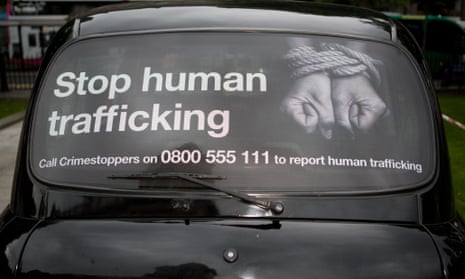Survivors of modern-day slavery, some of whom have endured horrific physical, psychological and sexual abuse at the hands of traffickers, are being abandoned and are at risk of being re-trafficked, according to a report published on Monday.
Vulnerable people, the majority of them women, are falling through gaps in government strategy, which leaves them exposed to homelessness and returning to traffickers, according to the report Life beyond the Safe House.
The Human Trafficking Foundation, which compiled the report, said urgent action is needed by government and local authorities to safeguard survivors, and more research was crucial.
As part of the government’s modern slavery strategy, those officially categorised as victims of modern-day slavery are offered a safe house and support for a minimum period of “reflection” of 45 days. But there is no obligation to monitor outcomes for people once they leave safe houses.
Those believed to be potential survivors can be given as little as 48 hours’ notice to leave a safe house if they fail to satisfy authorities they have been trafficked or exploited.
According to the report, many survivors felt abandoned once support was withdrawn and “treated like rubbish” with nobody caring for them as they tried to move on with their lives.
Some were placed in inappropriate housing – for example women who had previously been forced into prostitution were placed in mixed-sex accommodation – after leaving safe houses. Others found themselves placed in areas where they had previously been exploited and were at risk of isolation, trauma and depression.
“Many will still fear the traffickers, some may still have to pay off debts, others may be worried about returning home because of stigma and risk to their families, others who want to find work cannot do so because they feel unable to disclose details about their past or they have nowhere to live,” the report said.
One woman told researchers after leaving the safe house, the council placed her in a hostel living with eight women. “The people there were ex-prostitutes, drug addicts, or ex-offenders ... In these hostels, guests do drugs, drink and fight with each other.” She was bullied by another resident, who regularly took her food. “They should not have placed me there. I had been a prostitute, but not by my choice,” she said.
In 2014, 2,340 potential victims of trafficking were referred into the national referral mechanism (NRM), which assesses such cases – a 34% increase on 2013, and up from 1186 in 2012.
They included 1,669 adults, of which 1,084 were women. But this was the tip of the iceberg, said the report, as police records indicated the majority of potential survivors chose not to be referred.
The report calls on central government to issue guidance to local authorities to make adult safeguarding support more accessible to survivors. It also calls for each survivor to be allocated a specialist advisor until a settled solution is reached, and for detailed move-on care plans, including an individual risk and needs assessment, to be drawn up for every survivor.
People should be monitored for up to two years, whether they remain in the UK or return to their country of origin, the report recommends.
“The UK government has made some significant steps to address modern slavery in the UK by introducing new legislation – the Modern Slavery Act 2015 – as well as drawing up the modern slavery strategy and reviewing the national referral mechanism.
“However, our research shows that there is disparity between theory and practice. Unfortunately, there are many gaps within the current system that allow survivors of modern slavery to lose contact or “disappear’ soon after being found in the UK,” it said.
The report drew on face-to face interviews with 10 female survivors living in London, who came from countries including Albania, the DRC, Nigeria, and Vietnam, and examined evidence submitted by NGOs, local authorities and the Metropolitan police.
“A significant proportion of survivors are failed after leaving government-funded safe houses in London. However, this problem is not London-specific, but occurs nationwide. Potential victims of modern slavery have been, and are currently being, identified across the UK as highly vulnerable and traumatised,” it said.
“They may be accommodated and provided with safety and support for a short period of time, but then they must find their own way to survive, instead of being supported and empowered.
“Unfortunately for some of them, this means either becoming homeless, going back to the control of traffickers, or falling back into abusive or exploitative situations. The extent to which this is happening is unclear due to the lack of long-term monitoring, and therefore a lack of date-based evidence.”
One anti-trafficking consultant told the report’s authors: “My experience with the clients who have been though the 45 days period is that they end up on the streets again. They are so incredibly vulnerable because their wounds have been opened up, but they only have 45 days to deal with those wounds, and it’s not fair, but after 45 days they’re out.”
She added: “All this help is thrown at them, they are safe, and in the blink of an eye, it’s gone.”
